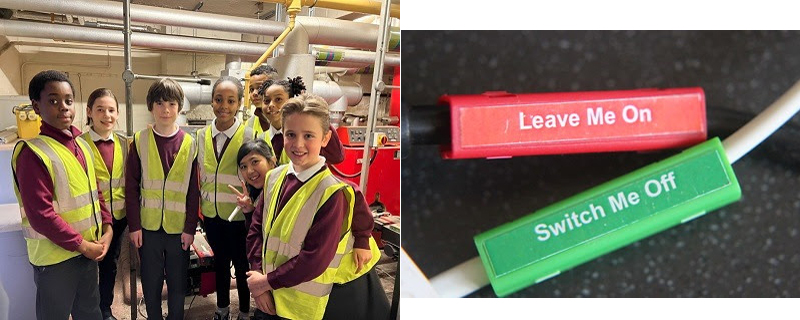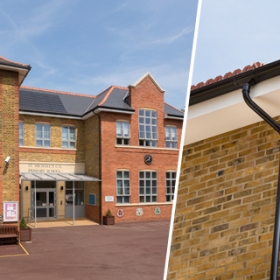‘National emergency retrofit response’ needed for UK schools
Photos: Students at Dalmain Primary School in Lewisham, London, in front of their new ground source heat pump – a renewable and much cheaper source of energy. Credit: Dalmain School and Simple behaviour changes could save schools a lot of money but the most significant savings in bills and carbon will come from retrofitting – extensive insulation and smart energy use – plus using lower cost energy from renewable sources. Credit: Ashden
Let’s Go Zero, the campaign supporting schools to be zero carbon by 2030, is calling on the new Secretary of State for the Department for Education to retrofit every school in the country, to ensure they stop leaking heat, carbon emissions and money. A rapid national retrofit rollout would protect children from the cold and help schools be able to plan in their long-term energy-related financial security.
In a recent survey of schools by Let’s Go Zero, 72 per cent of respondents mentioned that they are concerned or very concerned about keeping their schools warm this winter.
Today (21 Sept) the UK Government has announced a new Energy Bill Relief Scheme – a discount on wholesale gas and electricity prices for all non-domestic customers, which will help schools pay bills in the immediate term. But solutions for the long-term are still needed, says Alex Green, Programme Manager for Let’s Go Zero:
“This financial support will come as a welcome relief for schools, colleges and nurseries across the UK, but this is about paying bills – not about having long-term financial security or reducing carbon emissions. The Energy Bill Relief Scheme is merely a sticking plaster. Winter comes every year, so we need ambitious intervention by the new Secretary of State for Education, the Rt Hon Kit Malthouse MP to support energy efficiency, retrofit and renewables across all of our educational settings.”
The Let’s Go Zero campaign is advising schools all around the UK how to cut costs and carbon this winter – from simple interventions such as making sure heating systems and lighting are powered down when the school is not in use, to heating classrooms to only 19°C or running a switch off campaign with students. But they warn these are only stop gap measures.
1,700 schools, colleges and nurseries, representing nearly 850,000 students and 135,000 staff, have joined the campaign to show their intent and ambition to be zero carbon by 2030 and be part of the positive solution and stand alongside their students.
A key action would be to reduce the massive energy wastage that many schools suffer from as a result of old boiler systems, old draughty properties which leak heat, and lack of funds and capacity to improve energy efficiency. The new Secretary of State needs to act now to support our schools, colleges and nurseries.
“A retrofit energy saving overhaul will not only cut bills but will also ensure children have a warm place to learn in winter, save every school thousands of pounds that they can put into teaching instead of heating, and create jobs in every part of the country,” Ms Green continues.
“This needs to be a national emergency response. We owe this to our children, to our hard-working school staff, and to our communities in terms of putting into place the climate emergency response the government and local authorities have committed to.”
The Let’s Go Zero campaign say government help needs to come in the form of increased funding for schools to carry out retrofit which includes high grade insulation on walls, floors and roofs to stop energy leakage, and install renewable energy fuel sources such as solar and wind power or heat pumps. A government focus on training the construction and heating industries on retrofit techniques and renewable heating systems is also vital.
One renewable energy source which could be very useful for schools nationwide is ground source heat pumps.
Schools are ideal environments for this technology as they have control over the land that the heat pump is installed into and the pumps can be installed without any major disruption. They also have the significant advantage of being able to cool a building in summer.
Ian Goodchild, Director of Non-Domestic Sales at Kensa Heat Pumps says: “Ground Source heat pumps are a best fit for a majority of schools, due to offering the lowest carbon emissions, lowest lifecycle cost and most importantly right now, the lowest running cost solutions – this is due to the higher efficiency ground source systems can provide.
“Kensa’s experience of working with local authorities, such as Northumberland County Council, has proven that undertaking these retrofit projects for schools to improve thermal performance and reduce the carbon emissions by installing ground source, has helped them reduce their carbon emissions from heating by over 70 per cent at these sites.”
Schools that have implemented energy saving measures already include Dalmain Primary School in Lewisham, London, which has worked with school retrofit specialists Retrofit Action For Tomorrow (RAFT) and their local authority on retrofitting their old school building. By repairing their roof, installing wall and roof insulation and new roof lighting they have made an energy saving of 62 per cent.
Erika Eisele Head of Dalmain Primary School says: “Our buildings hadn’t been invested in for about 20 years, so were just haemorrhaging heat. It was really clear how inefficiently the building was working.” RAFT’s work included structural advice on the building and energy system, including installing a ground source heat pump, but also helping students and staff fully understand why the work was being done and the importance of energy saving.
Let’s Go Zero have published Energy Saving Quick Wins for schools and the Let’s Go Zero coalition of environmental NGOs – which includes GAP, Eco-Schools and WWF and others – provide support and resources to schools trying to prepare for the energy crisis.
Let’s Go Zero Energy Saving Quick Wins for schools:
- Get every department to do a Switch Off assessment for non-usage times – lights, computers, equipment, kitchen, science labs, etc. A 10% saving on an increased energy bill is significant – it could lead to £10k plus in savings (maybe £20-30k for a large secondary).
- Share information on increased energy costs to everyone in the school. Convert the increase into what else that money could buy (for instance a staff member’s salary or being able to buy in learning support).
- Ask for help – there is an enormous amount of help and guidance out there, from local authorities, environmental groups, local businesses and Let’s Go Zero.
- Explore energy efficiency and renewables support programmes – there are many ways to improve your estate with both government and private finance. Work with companies that have been recommended by another school, or through your local authority.
- Don’t turn heating on until at least October half term – and make sure that thermostats are set at the recommended temperature of 19 degrees centigrade for classrooms (most schools overheat the classrooms). Only heat the school when everyone is there – not from when the first person arrives and the last person leaves. Consider creating zones within your school – so you can individually control heating in different areas.
- Be ruthless about retaining the heat – ensuring that doors and windows are closed and that you have insulated wherever possible. Make sure your rental price to external organisations outside of school hours reflects the cost you are paying to heat and light the space.




Leave a Reply
Want to join the discussion?Feel free to contribute!